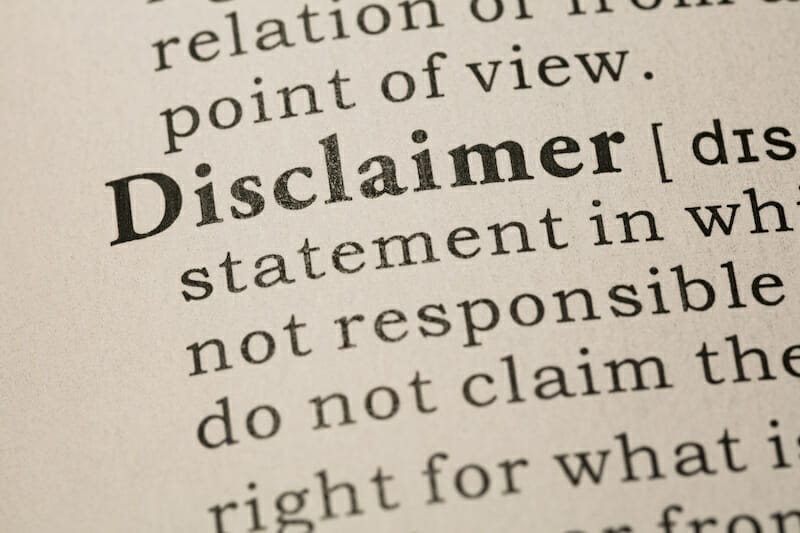Many authors assume that their book disclaimers are supposed to be boring. They presume some pricey lawyers devised standard legalese, and they dare not depart from the norm.
Not so. The law does not require a book disclaimer—a standard part of the front matter of many books—to be boring. In fact, just the opposite is true. The more interesting the disclaimer, the more likely it will be read. From a lawyer’s point of view, a well-written, well-read disclaimer is best of all.
Many writers have a lot of fun with their disclaimers, particularly for memoirs. Here’s what we’ll look at in this article:
What Is the Disclaimer at the Beginning of Every Book?
A book disclaimer is a simple statement, 1-3 sentences at most, in which the author declares any name changes, timeline disparities, or, in the case of a novel, that any character’s resemblance to real, living persons is just a coincidence. (Even if it’s really not! Wink wink!) This absolves you, the author, from any legal challenges relating to the privacy or defamation of people you’re writing about.
Where Would a Book Disclaimer Go?
If you choose to include a book disclaimer, it will go on the copyright page. Generally, it will appear at the bottom of that page, after all the actual copyright and printing information. This is the best location for a disclaimer since it technically and legally alerts readers from the get-go, before they ever get to your book content, that you are legally absolved of libel and other misuses of language.
How to Write a Disclaimer: Examples for Fiction
Every reader is familiar with the typical fiction book disclaimer.
This is a work of fiction. Names, characters, business, events and incidents are the products of the author’s imagination. Any resemblance to actual persons, living or dead, or actual events is purely coincidental.
I find nothing wrong with this disclaimer, except that it won’t work in many instances. What if your novel includes real events, places, and historical figures? What if parts of your book are based on your own life?
Let’s take a look at how some authors have dealt with these issues. Tom Wolfe in the book disclaimer for A Man in Full, acknowledges that parts of his story are from real life:
This novel’s story and characters are fictitious. Certain long-standing institutions, agencies, and public offices are mentioned, but the characters involved are wholly imaginary.
Margaret Atwood in Cat’s Eye tries to dispel readers’ assumptions that the book is the alter-ego of the writer:
This is a work of fiction. Although its form is that of an autobiography, it is not one. Space and time have been rearranged to suit the convenience of the book, and with the exception of public figures, any resemblance to persons living or dead is coincidental. The opinions expressed are those of the characters and should not be confused with the author’s.
A book disclaimer can also set the historical context. In my novel Coyote Winds, I inserted:
Coyote Winds is a work of fiction. Any resemblance to actual events or persons, living or dead, is entirely coincidental. The Dust Bowl and the Great Depression, however, were very real. For the purpose of the story, I condensed some of the historical events into two years, while in reality the dust storms, food riots, and other historical events played out over several years.
Suppose you’ve taken a historical figure and given him dialogue and personality. Here’s the book disclaimer D. M. Thomas used to deal with Sigmund Freud as a character in The White Hotel:
The role played by Freud in this narrative is entirely fictional. My imagined Freud does, however, abide by the generally known facts of the real Freud’s life, and I have sometimes quoted from his works and letters, passim. The letters . . . and all the passages relating to psychoanalysis . . . have no factual basis.
The lesson here is if you’ve taken liberties with historical facts and figures, be open about it. Make your disclaimer part of the experience of the book.
How to Write a Book Disclaimer: Examples for memoir
Many memoirists use plain vanilla disclaimers such as:
This book is memoir. It reflects the author’s present recollections of experiences over time. Some names and characteristics have been changed, some events have been compressed, and some dialogue has been recreated.
That works fine, but some of the great memoirists use their literary voices to a much better effect.
Mary Karr, in her memoir The Liars’ Club, apologizes for nothing. She starts the book with her sister asking her mother whether a bullet hole in the kitchen wall happened when her mother shot at her father.
No, her mother explained. That’s where she shot at Larry. She points at another wall. “Over there’s where I shot at your daddy.”
As Karr explains, “when fortune hands you such characters, why bother to make stuff up?”
In This Boy’s Life by Tobias Wolff, buries his disclaimer in his acknowledgments. As he thanks those who read drafts of the book, he says:
I have been corrected on some points, mostly of chronology. Also my mother claims that a dog I describe as ugly was actually quite handsome. I’ve allowed some of these points to stand, because this is a book of memory, and memory has its own story to tell. But I have done my best to make it tell a truthful story.
How to Write a Disclaimer: Examples for Nonfiction
Interesting, I thumbed through a lot of nonfiction books and found no disclaimers. I suspect the authors and publishers stand on their own research without hiding behind a book disclaimer. But I found a great one in Rebecca Skloot’s The Immortal Life of Henrietta Lacks. Her disclaimer turns the traditional fiction disclaimer on its head:
This is a work of nonfiction. No names have been changed, no characters invented, no events fabricated.
In contrast, any book giving professional advice, whether it’s business, legal, medical, or tax advice, is full of disclaimers. For my book, Self-Publisher’s Legal Handbook, I go on and on with disclaimers, including the following:
Although I am a lawyer, I am not your lawyer. Reading this book does not create an attorney-client relationship between us. . . . This Handbook should not be used as a substitute for the advice of a competent attorney admitted or authorized to practice in your jurisdiction.
A financial advice disclaimer could say:
“It is not intended to be a source of financial or legal advice. Making adjustments to a financial strategy or plan should only be undertaken after consulting with a professional. The publisher and the author make no guarantee of financial results obtained by using this book”
Along with that, you might want to include a disclaimer for any coaching program results:
Please note that I don’t make any guarantees about the results of the information applied [on this website/material]. I share educational and informational resources that are intended to help you succeed in [coaching area]. You nevertheless need to know that your ultimate success or failure will be the result of your own efforts, your particular situation, and innumerable other circumstances beyond my knowledge and control.
The Legal Effect of Disclaimers
Legal disclaimers are like chicken soup when you have a cold. They can’t hurt and might help. While they are unlikely to stop a lawsuit, they may put an obstacle in the way. In at least one lawsuit, disclaimers became part of the solution.
Augusten Burroughs’ originally released Running with Scissors as a memoir. Then both Burroughs and his publisher were sued for liable by a family who claimed they were portrayed negatively in the work. As part of settling the case, the book was relabeled as a novel and disclaimers were added, including:
I would like to thank the real-life members of the family portrayed in this book for taking me into their home and accepting me as one of their own. I recognize that their memories of the events described in this book are different than my own. They are each fine, decent, and hard-working people. The book was not intended to hurt the family. Both my publisher and I regret any unintentional harm resulting from the publishing and marketing of Running with Scissors.
Bottom line: spend a little time on your book disclaimer. Use it as an opportunity to explain your purpose and point of view, and most of all, to highlight your literary voice.
Attorney and author Helen Sedwick uses thirty years of experience to show writers how to stay out of court and at their desks. ForeWord Review gave her Self-Publisher’s Legal Handbook five stars, calling it “one of the most valuable resources a self-publisher can own . . . well-written and authoritative yet unhampered by legalese.” For more information about Helen and her work, go to https://helensedwick.com.
Disclaimer: Helen Sedwick is licensed to practice in California only. This information is general in nature and should not be used as a substitute for the advice of an attorney authorized to practice in your jurisdiction.
Photo: pixabay.com



